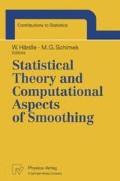Summary
In this study we propose a method for fitting extreme percentile regression based on the r extremes corresponding to each value of a scalar covariate. The estimation is performed by maximum penalized likelihood, exploiting results from extreme value theory. Confidence bands for the true conditional percentile are constructed using a bootstrap algorithm.
Access this chapter
Tax calculation will be finalised at checkout
Purchases are for personal use only
Preview
Unable to display preview. Download preview PDF.
References
Arnold, B.C., Balakrishnan, N. and Nagaraja, H.N. (1992). A first course in order statistics. John Wiley and Sons Inc., New York.
Becker, R.A., Chambers, J.M. and Wilks, A.R. (1988). The new S language. Wadsworth and Brooks, California.
Boos, D.D. (1984). Using extreme value theory to estimate large percentiles. Technometrics, 26, 33–39.
Castillo, E. (1988). Extreme value theory in engineering. Academic Press Inc., New York.
Chambers, J.M. and Hastie, T.J. (1993). Statistical models in S. Chapman and Hall, New York.
Cole, T.J. (1988). Fitting smoothed centile curves to reference data. J. of the Royal Statistical Society Soc. A, 151, 385–418.
Cole, T.J. and Green, P.J. (1992). Smoothing reference centile curves: the LMS method and penalized likelihood. Statistics in Medicine, 11, 1305–1319.
David, H.A. (1981). Order Statistics. John Wiley and Sons Inc., New York.
Efron, B. (1991). Regression percentiles using asymmetric squared error loss. Statistica Sinica, 1, 93–125.
Goldstein, H. and Pan, H. (1992). Percentile smoothing using piecewise polynomials, with covariates. Biometrics, 48, 1057–1068.
Green, P.J. and Silverman, B.W. (1994). Nonparametric regression and generalized linear models: a roughness penalty approach. Chapman and Hall, London.
Hardle, W. (1991). Applied nonparametric regression. Cambridge university press, Cambridge.
Hastie, T.J. and Tibshirani, R.J. (1990). Generalized additive models. Chapman and Hall, London.
Healy, M.J.R., Rasbash, J. and Yang, M. (1988). Distribution-free estimation of age-related centiles. Annals of Human Biology, 15, 17–22.
Hendricks, W. and Koenker, R. (1992). Hierarchical spline models for conditional quantiles and the demand for electricity. J. of the American Statistical Association, 87, 58–68.
Koenker, R. and Basset, G. (1978). Regression quantiles. Econometrica, 46, 33–50.
Koenker, R., Pin, N. and Portnoy, S. (1994). Quantile smoothing splines. Biometrika, 81, 673–680.
McDonald, J.A. (1982). Projection pursuit regression with the ORION I workstation. A 25 minute film, available from Jerome H. Friedman, Computation Research Group, Bin 88 SLAC, P.O. 4349, Stanford, CA 94305.
Smith, R.L. (1986). Extreme value theory based on the r largest annual events. J. of Hydrology, 86, 27–43.
Smith, R.L. (1989). Extreme value analysis of environmental time series: an application to trend detection in ground-level ozone. Statistical Science, 4, 367–393.
Smith, R.L. and Huang, L.S. (1993). Modelling high threshold exceedances of urban ozone. National institute of statistical sciences. Technical report # 6.
Weissman, I. (1978). Estimation of parameters and large quantiles based on the k largest observations. J. of the American Statistical Association, 73, 812–815.
Author information
Authors and Affiliations
Editor information
Editors and Affiliations
Rights and permissions
Copyright information
© 1996 Physica-Verlag Heidelberg
About this paper
Cite this paper
Rosen, O., Cohen, A. (1996). Extreme Percentile Regression. In: Härdle, W., Schimek, M.G. (eds) Statistical Theory and Computational Aspects of Smoothing. Contributions to Statistics. Physica-Verlag HD. https://doi.org/10.1007/978-3-642-48425-4_15
Download citation
DOI: https://doi.org/10.1007/978-3-642-48425-4_15
Publisher Name: Physica-Verlag HD
Print ISBN: 978-3-7908-0930-5
Online ISBN: 978-3-642-48425-4
eBook Packages: Springer Book Archive

